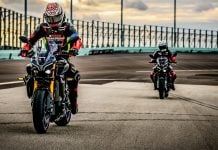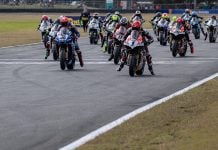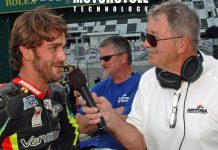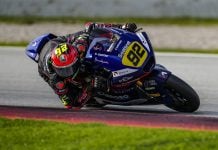New machines and world-level racers took the stage at the Long Beach, California stop of the Progressive International Motorcycle Show, with a supporting cast of high-level executives on hand to talk about the upcoming year. Taking center stage was the new from the ground-up Ducati 1199 Panigale, making its official North American debut although the bike had been shown briefly in Dallas the week before, Ducati officials said. The chassis-less or monocoque, as Ducati officials described it motorcycle is the result of Ducati engineers drawing inspiration from the “red cars and the yellow cars” in the Bologna region, and is the result of Ducati engineers having complete freedom in designing the next generation of Superbike. “We told them, you have a blank page. You can do whatever you want “¦ you just have to redefine what is a Superbike for the next 10 years,” said Dominique Cheraki, general manager of Ducati North America. The base model lists at $17,995, pumps out 195 horsepower and weighs 361 pounds, approximately the weight of a Japanese 600cc Supersport. There are no plans for a carbon-fiber chassis version of the bike, nor an “R” version as the company has offered in the past for its Superbike-platform models, Cheraki says. “At this stage, there is no reason for an ‘R’ model,” he says. “This model has everything needed for Superbike competition.” Still, the 1199 will not see Superbike competition until the 2013 season. Cheraki says it is because Superbike racing is so highly competitive, and the machines so finely tuned, the company does not want to go racing at that level until the bike has been developed into a competitive package. At this point, there are only two or three fully-assembled 1199s in existence. There is not enough time to develop the bike before the World Superbike season starts, and Cheraki says “we do not want to show up and develop the bike during the races.” Instead, the company will race the new model in 2012 in FIM 1000cc Superstock European Championship races, gathering data to develop the 1199 into a Superbike platform. It will be a tough year for Ducati in Superbike, with defending World Champion Carlos Checa’s aging 1098R being hit with a weight penalty the result of his complete domination of the series in 2011. The six-kilogram weight penalty, Cheraki says, will result in Ducati’s race bikes weighing the same as a street-ready 1198S in other words, he says, “You can go race with the lights, the turn signals, everything.” Cheraki says Ducati is hopeful that the 1199 series is as long-lived as the company’s beloved 916-based series, which was a front-line Superbike for years as the company updated and refined the engine and running gear. “This engine [in the 1199] is the first engine we have created from a blank slate in almost forever, so there is a lot of room for development,” he says. “With the 916, through the 998, it was not a problem to have a motorcycle on the market for six, seven years. Now, it has to be renewed every couple of years. The speed [of development] is good for the customer, but for us it is a nightmare.” Honda’s new CBR1000RR was on display, showing off its renewed clothing and running gear for 2012. American Honda’s Jon Seidel said the changes on the bike especially the new rear suspension, which is said to have no “dead zone” in the response curve, and the new fuel injection settings are subtle individually, but combine to make a noticeable difference in the way the rider can get on the throttle coming out of the corners. “The system has been tested in the All-Japan series for the past year, and it was on the (Suzuka) 8-Hour bikes,” Seidel says. The machine’s optional, electronically controlled Combined ABS (C-ABS) anti-lock brake system–which links the front and rear brake systems–has been altered with revised front/rear braking force bias; applying the rear brake pedal now provides less braking force at the front, Seidel says. Honda’s website description of the system says, “All-new, electronically controlled Combined ABS distributes brake force over both wheels, helping to maintain braking confidence in less than ideal conditions. Electronic measurement of rider input on each brake lever permits application of only the front or rear brake in some cases, while the system combines both brakes in others.” Yamaha brought three of its top road racing stars to the show, with two-time AMA Pro Superbike Champion Josh Hayes, AMA and World Superbike champion and MotoGP race winner Ben Spies and 2011 MotoGP Rookie of the Year Cal Crutchlow on hand. Spies, as usual, was his open, unpretentious self, describing his season as “the most inconsistent year I’ve ever had” and winning the Assen GP as “a dream” that had come true. And while Spies says he wished he had won the final GP of the season, where he led out of the final corner only to be pipped at the line by 2011 MotoGP World Champion Casey Stoner, Spies pointed out that the race had come after what he called “the worst four weeks I’ve ever had on a motorcycle,” with six crashes in six sessions, and he was happy with second. Hayes, who rides his AMA-spec Yamaha YZF-R1 with a minimal amount of electronic rider aids, was asked what it was like to ride the MotoGP bike with a whole host of sophisticated electronics. Hayes cracked that he was going from a Superbike with “200, maybe 205 horsepower” to a MotoGP bike with somewhere near 240 horses that weighed 60 pounds less; “You’re probably going to need some electronics,” Hayes quipped. With MotoGP’s 1000cc era slated to open in 2012, Crutchlow opined that the bigger engines wouldn’t make a huge amount of difference, but they would allow riders to recover from tiny mistakes. “You can be off-line a half an inch “¦ and actually make it up,” Crutchlow said.
Updated: New Bikes, Top Talent: Progressive International Motorcycle Show Opens With Media Day In Long Beach, California
Updated: New Bikes, Top Talent: Progressive International Motorcycle Show Opens With Media Day In Long Beach, California
© 2011, Roadracing World Publishing, Inc.





